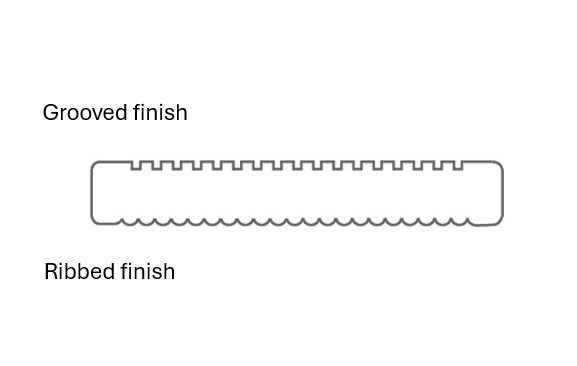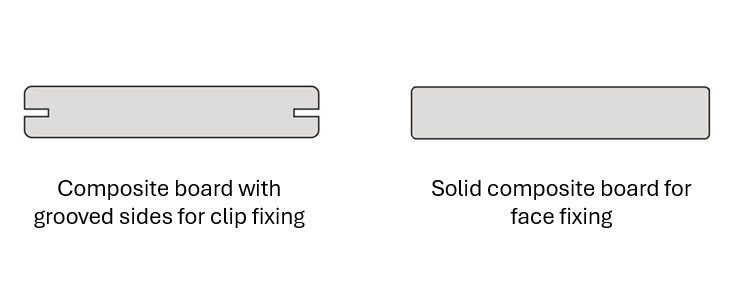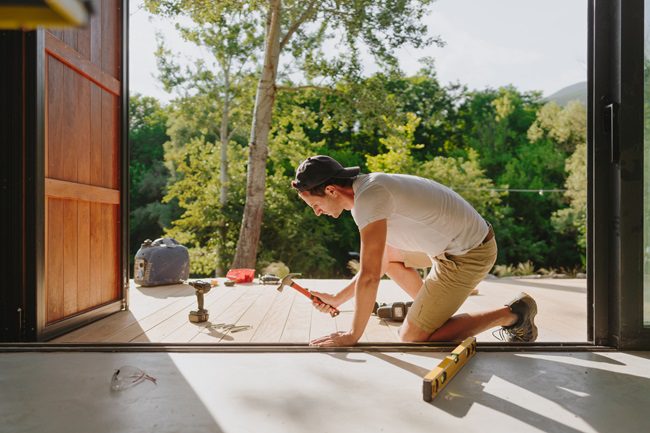There are many types of composite decking to choose from and it can often be overwhelming to understand your options. One area of confusion is around the reference to ‘grooved’ and ‘ungrooved’ decking boards. In this blog we will explain the different meanings for grooved and ungrooved decking, so you can ask the right questions and make informed decisions.
When you hear people referring to grooved and ungrooved deck boards, they can be referring to two different characteristics of the board:
- A grooved or ungrooved finish to the surface of the deck board
- Whether the board has a groove down the side of the board for installation purposes
Let’s take each in turn:
1. A grooved or ungrooved finish to the deck board
Whether you choose to have the surface of your deck board grooved or ungrooved will change the final appearance of your decking. A grooved surface will have small grooves carved into the board’s surface and will offer a contemporary look. An ungrooved surface will usually have a woodgrain finish and be more traditional in appearance.
Often boards with a grooved finish will be reversible with wider grooves on one side and a narrower ribbed effect on the other. This makes the board very versatile, as both finishes can be used in the same project. For example, using the wide grooved boards for the main decking area, with the narrow ribbed side for the picture frame decking around the edge, or using different sides in a patchwork or transition decking pattern.
Our Signature AT, Signature HD and Essentials ranges have ribbed and grooved surfaces, with the Signature collections being reversible.
Below you can see a composite deck board with a ribbed finish on one side and grooved finish on the other:

2. A grooved indent down the side of the board for clip installation
The second reference to grooved boards is used when referring to their installation method.
A deck board with grooves along both sides of the board will be installed using a hidden clip fastening system. An ungrooved deck board that has smooth rectangular edges will be installed with composite decking screws, from the top down – also known as face fixing.
Below you can see a composite deck board with grooves down the sides for clip fixing versus a solid board with no grooves for face fixing:

Choosing boards with grooved sides for clip fixing
The main benefit of this type of grooved decking is that you can use hidden clip fasteners when installing your new decking. This results in a clean, contemporary fastener-free surface. Check out our Evolution collection, which is a next generation, capped deck board with grooves down the sides for clip fixing.
Installing grooved decking boards
Installing grooved decking boards is relatively simple and quick. With the hidden fastening method of installation, the fasteners go into the grooved sides of the boards, holding them in place and concealing the fittings from above.
Specific attention should be given to the position of the fasteners, the fastener application, and the spacing between the boards. You’ll find detailed information on this in the manufacturer’s guidebook which you should read prior to kicking off your project.
Choosing boards with ungrooved sides for face fixing
The main benefit of ungrooved (or solid edge) decking is its likeness to traditional timber decking in terms of appearance and installation. For anyone used to fitting traditional deck boards they may find ungrooved boards easier to face fix, rather than learning to use a clip system. Check out our uncapped Heritage, Signature AT and Essentials collections.
Installing ungrooved decking boards
Ungrooved deck boards are fixed from above using screws to secure in place into the joist below. We offer coloured screws to match the colour of your decking if you want a more streamlined finish. Again, always read the manufacturer’s instructions prior to embarking on your project.

Grooved versus ungrooved
When talking about grooved or ungrooved decking, always be clear whether you’re meaning the surface of the board versus the grooved / ungrooved sides for fixing. Once clear on the difference you can then make informed decisions about the style and finish you’re looking for.
There’s no right or wrong answer. It all depends on your personal preference and overall look you wish to achieve.
Why not browse our range of composite decking for inspiration and request some free samples? And if you’re still unsure of the best option for you, call our friendly, knowledgeable team today on 01978 667 840 for a no obligation chat.
